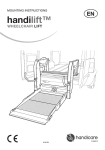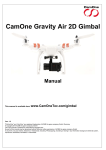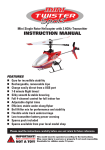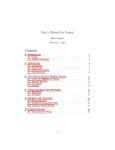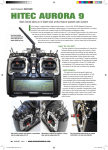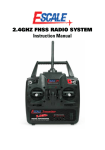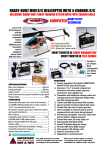Download Twister Police Helicam Review
Transcript
ON TEST TWISTER POLICE HELICAM TWISTER POLICE HELICAM First of all, I apologise for the title of this review, but it is fairly accurate - this is a great looking, semi-scale replica of a Police chopper, equipped with an on-board video camera, and whilst making the video that features on the Rotorworld website, my cameraman shouted to me “Action!”, to which I spontaneously shouted back “Police, camera!” and we then agreed this must be the title of the article. Of course the camera part of this product is undoubtedly the most interesting feature of this package, but having spent some time with the Police Helicam, I can report that the helicopter itself is a very nice machine and a much better flyer I think, than a lot of similar co-axials on the market. Features at a glance The comprehensive package includes the heli, transmitter, spare blades, tools, battery and charger • Fitted with an FlyCamOne Eco to record your flights • So stable - it almost flies itself! • Checked, test-flown and flight guaranteed from the factory • With LBW & MOPS (low battery warning and motor overlaod protection) • Comes with Planet T5p 2.4GHz transmitter and R6M 2.4GHz receiver • Rechargeable LiPo battery, 12V fast charger, 240V power unit included • FREE - four spare main rotor-blades plus four AA batteries for transmitter TWIST AGAIN I always like having the opportunity to review one of J Perkins’ Twister helis as they not only offer a great product for the money, but in my experience have excellent user manuals and don’t skimp on the few extra touches that make the buyer just that little bit happier. I mean, POLICE CAMERA ACTION TOM STACEY NORMALLY FILMS AND PRODUCES A LOT OF VIDEOS FOR ROTORWORLD SO IT SEEMED ONLY FITTING THAT WE LET HIM HAVE A PLAY WITH THIS LATEST HELI FROM J PERKINS WHICH IS FITTED WITH AN ON-BOARD FLYCAMONE ECO CAMERA A semi-scale heli with a camera on board is the perfect distraction for Rotorworld’s Tom Stacey for example, a set of extra blades (which I did end up using!), a set of batteries for the transmitter and a box that doubles up as a sturdy, reusable carry case. Okay, a lot of RTF machines now come in a box that will do double duty as a carry case, but the Twister one is a lot less of a fiddle to use and seems more robust to me. The decent user manual is also a hugely important thing for beginners, and I can’t count the number of times I have spoken to those just getting in R/C helicopter flight who have been disappointed by, or destroyed their new toy due to not understanding fully how it should be used and controlled. One of the common reasons for this misunderstanding was the manual was badly written or didn’t cover everything the beginner should know in sufficient detail. Aside from all this, the design and quality here from Twister is pretty much comparable to the competition, but it is nice to have a good supporting package. So, what do you get in the box? Well firstly a mains charger which is a foolproof design that charges the small 3S rechargeable LiPo battery which you of course fit into the helicopter. This charger can be powered via 12 volts or 240 and you get a mains Here you can see the on-board FlyCamOne Eco camera fitted under the heli. The angle is adjustable before flight through around 110 degrees 10 SEPTEMBER 11 adaptor included. The Planet compatible transmitter is 2.4GHz and usefully only uses four AA batteries rather than the eight used by some similar sets. Of course, in addition to all these bits you also get the helicopter itself, and the FlyCamOne Eco system is pre-fitted and ready to go (minus, oddly a micro SD card which you need to actually take any footage). A cable to interface with your PC and download footage is similarly not included, although you could always remove the Micro SD card and plug this directly into your computer or smartphone provided you have the correct socket. BUILT TO LAST With everything taken out of the box, the first thing I did was take a look over the construction of the helicopter itself. As soon as you pull it out, you notice the size of it - this is a big machine, certainly bigger than other scale co-axials such as the E-Flite Blade CX3 (to which it is quite similar looking). This should make it more stable when flying outside, and also allows for the bigger blades and motors to provide the oomph to lift the extra weight of the camera system into the air. The full fuselage is a beautiful looking moulding and like a lot of Twister’s other helis, isn’t based on any particular real deal, Behind the camera is the control unit which contains a slot for a micro SD card and a mini USB port. A ribbon cable connects it to the camera SEPTEMBER 11 11 TWISTER POLICE HELICAM TWISTER POLICE HELICAM The 800mAh LiPo gives flight times of around five to six minutes and is charged through the balance port Twister’s familiar charger can be powered via the mains or usig a 12 volt battery or power supply The five channel Planet compatible transmitter features 2.4GHz technology and a toggle switch for the camera The excellent manual which will help beginners to understand all the ins and outs of their new helicopter Tom reports that the Police Helicam flies great outdoors when the conditions are right, i.e. not too much wind A slight ‘coming together’ with a bush in the woods caused damage to the canopy mount, but this was easily and cheaply repaired 12 SEPTEMBER 11 but looks realistic enough as a generic civilian model. Unlike most machines in this class, where the fuselage is push-mounted on rubber grommets, the Police Helicam’s is held on with screws that connect via silicone tubing directly to the frame and this is due, most likely, to the mounting of the camera recording hardware, and needing a little more security than gromits. Another obvious feature that is worth comment is the tail rotor because oddly, for a co-axial (which doesn’t need one) the Helicam has a tail rotor, but it doesn’t do anything! It does turn round if you attempt to turn it, but that’s about it. I can only assume it is a cosmetic addition, but it is strangely out of place. Further adding to the cool scale features though are a full set of LED lights, including a blue flashing one which flashes when the LiPo battery starts to get low. It’s a shame this doesn’t flash all the time, as the effect is perfect on a Police styled heli, but you can’t have everything, plus the low battery warning feature is very useful to prevent damage to the helicopter and the LiPo battery. The rest of the heli is fairly typical four-channel RTF fayre, but I did like the fact that the motors have heatsinks on them, as a common problem on co-axials with fully enclosed fuselages is that the motors get pretty hot (remember there are two of them rather than one with a single rotor). The Planet compatible receiver is a five-channel, rather than the usual four you would get, and this is to enable you to control the on-board camera remotely. And this of course brings us round to what is the stand out feature of this model: the FlyCamOne Eco video and stills digital recording system. This German designed and built system is a radio controlled, VGA resolution, SD compatible video system that incorporates a camera module, and separate control and recording module. VGA resolution is 640x480 pixels, which is somewhere between normal standard and high definition television. It is comparable to a mobile phone video, so it’s not exactly broadcast quality, but more than enough to have some fun, or upload to YouTube for instance. When I say SD compatible, I am referring to the recording media it uses. Micro SD cards are a fairly industry standard solid state memory chip that you can plug into most computers with the correct reader and usefully, a lot of mobile phones. This system is not one of the currently fashionable FPV (First Person View) systems that stream video back to a pair of glasses or display, but rather you can take videos and pictures of the landscape as you fly. This is of course a novelty more than anything else (although this is what real Police helicopters do), but is does provide a very intriguing new insight into RC flying. How often have you wondered what the view is from your heli? I know I have, and watching back the footage is a surprisingly addictive activity. MAJOR TOM TO GROUND CONTROL I’m sure you are wondering how you control the video system, so I will report back that it is a very easy process. Of course, you mustn’t forget to insert an SD card before attempting to take any video, especially not when it is for a review (I wonder who would do that? - Ed). So with the card safely installed, the camera system is armed and ready as soon as the rest of the radio system is. The transmitter has a fifth channel toggle on the top right, and essentially you just hit this once and the film is rolling, and again to stop. An LED on the board will change from green to red when recording, and it just keeps capturing until the memory is full. For reference, a one minute video at 30fps is around 40-45 megabytes, so even a cheap low capacity card will give you enough space to record for an entire battery pack. If you want to switch to stills mode, then a three second pull on the toggle on the transmitter will change modes. There is also something called serial single shot which automatically takes one photo every four seconds, so you can get some quite cool looking time lapse footage with this mode should you wish to. Once you have finished videoing your neighbourhood, all you need to do is connect a mini USB cable to the heli to import what is stored, or remove the card and put it in your reader. Importing via USB is very slow, and downloading 5 minutes of footage took about 11 minutes to complete. Using a card reader was a lot quicker in my testing though, so if you have this option, then it is preferable. You don’t get any software to import the movies with the package, but I found that it just mounted as a removable disk on both Windows and Mac OS X, and I used the standard tools available in the OS to grab the footage. Another oddity was that the date of the videos was set as being taken in 1960, perhaps this equipment was a highly secret MI5 prototype from a 60’s Bond film originally? Although it doesn’t really matter, it certainly confused the iPhoto software on my Mac, with the videos being annoying placed right at the beginning of my photo library, rather than the end with the rest of my recent imports! Overall though, the videos imported without much trouble and the quality is surprisingly good, especially when you consider it is included for free with a very well priced RTF machine. FLIGHT TEST Of course, this wouldn’t be a model helicopter review without some testing of the helicopter in flight, and so as well as playing a lot with the FlyCamOne system, I also flew it around at my regular indoor club, and also outside at the park. As this model comes test flown and guaranteed to fly, then I will spare any lengthy setup and tweaking speak because there wasn’t any. TECH SPEC Twister Police Helicam Model type: RTF micro electric co-axial Length: 480mm Main rotor Dia: 445mm Flying weight: 220g RRP: £149.99 FlyCamOne Eco camera Resolution: VGA 640 x 480 pix USB: 1.1 Mini USB FPS: 28 Power: 4.5 - 6 Volts Focus: 0.3m - ∞ Weight: 17g Modes: Video/Serial Picture/Single Photo Available from: All good model shops UK distributor: J Perkins Distribution Tel: 01622 854300 Web: www.jperkinsdistribution.co.uk This is truly a case of pull it out of the box and fly. And fly it does very well too - no co-axial is going to set the world alight with a dynamic flight envelope, but indoors, or outside on a very calm day, the Twister flies very well indeed. It is of course, exceptionally stable and also provides very positive tail response and very little tail drift, even as the battery pack drains. In the instruction manual it says that this helicopter is capable of speeds up to 20mph, but trust me, it isn’t! 2mph perhaps, but this is not a machine built for speed, rather one built for stability, and with the camera system, this is quite understandable. I probably clocked up about an hours flying time before writing this review, and it was always a solid and fun flying companion. I did however have one big crash, where I was too busy trying to play with the camera modes than looking where I was going and hit a tree and then the ground. Damage ran to one broken skid (that I could have glued back together), two blades (replacements were in the box) and two broken canopy mounts. The worst thing was the canopy mounts, but as these are essentially silicone tubing, most model shops would have some in stock and you would be up and flying quite quickly and cheaply. Thankfully, none of the expensive electronics were damaged, and that goes to show that the canopy mounting system is as it is, for a reason. The model looks great in the air, and being able to capture bird’s eye video is a brilliant feature THE VERDICT... Overall this is a great flying co-axial, and is a fair amount larger than many in its class, without being too big as to be a bit pointless. It is primarily of course, an indoor class helicopter, but as you can see from our photos, it works well outdoors if the conditions are right. I really liked the novelty of the camera, and it certainly added an extra dimension to my normal flying videos, by being able to combine first, and third person views. The lack of memory card or cables is a bit of a pain, but it does keep the price down if you already have these anyway. I particularly liked the excellent and easy to follow manual, and the scale appearance of the heli, which especially with the LED lights is top notch. Perhaps not a model for everyone, but I know for sure it will get plenty of use on my regular fleet. Watch our video online! You can watch Tom’s exploits with the Police Helicam on YouTube at the following address http://tiny.cc/bfnzo And of course, Rotorworld’s website at www.rotorworld.co.uk gets regularly updated with flying videos of other models and competitions. A full set of LED lights adds to the scale appearance and are another bonus in a well rounded package SEPTEMBER 11 13


